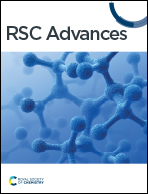Highly sensitive benzothiazole-based chemosensors for detection and bioimaging of peroxynitrite in living cells†
Abstract
It is well accepted that peroxynitrite (ONOO−) plays a crucial role in various physiological and pathological processes. Thus, the detection and imaging of ONOO− in vitro and in vivo with high selectivity and sensitivity is of great significance. Here we report two simple benzothiazole-based fluorescent chemosensors, BS1 and BS2. Under physiological pH, both probes could quickly sense ONOO− with a remarkable “turn-on” fluorescence signal at 430 nm. The limit of detection (LOD) of BS1 and BS2 toward ONOO− was 12.8 nM and 25.2 nM, respectively, much lower than the reported values. Experimental results indicated that BS1 with a diphenyl phosphonate unit presented higher selectivity for ONOO− than BS2. Furthermore, based on the advantages of lower cytotoxicity and pH-stabilities of BS1, probe BS1 was successfully employed to detect and image ONOO− in HepG2 cells. More importantly, we used BS1 to successfully showcase drug-induced hepatotoxicity via imaging ONOO− upregulated by acetaminophen (APAP), and also evaluated the remediation effect of GSH. All the results illustrated that the fluorescent probe BS1 has great potential for the detection of ONOO− and to further uncover the roles of ONOO− during the drug-induced liver injury (DILI) process.



 Please wait while we load your content...
Please wait while we load your content...